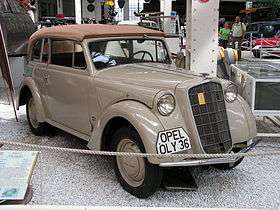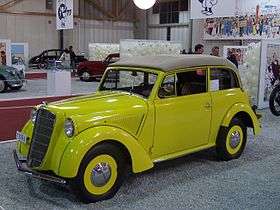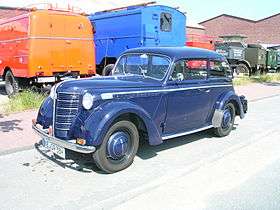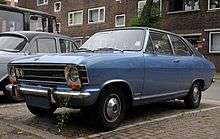Opel Olympia
The Opel Olympia is a compact car produced by the German automaker Opel from 1935 to 1940, from 1947 to 1953 and again from 1967 to 1970.
| Opel Olympia | |
|---|---|
 1936 Opel Olympia | |
| Overview | |
| Manufacturer | Opel |
| Production | 1935–1970 |
| Body and chassis | |
| Class | Compact / Small family car (C) |
| Chronology | |
| Predecessor | Opel 1.3 litre |
| Successor | Opel Rekord/Opel Ascona |
The 1935 Olympia was Germany's first mass-produced car with an all-steel unitized body (monocoque).[1] This revolutionary technology reduced the weight of the car by 180 kilograms (400 lb.) compared to its predecessor.[2] Production of the unibody design required new production methods and materials. Spot welding, advanced types of steel, and a new production line layout were among the many advances introduced by the Olympia.[3]
The car was first presented in February at the 1935 Berlin Motor Show; production got under way later during that year. The Olympia was named in anticipation of the 1936 Berlin Olympic Games.[4] The pre-war Olympia was made in two versions: From 1935 to 1937 the Olympia had a 1.3-litre engine; for the OL38 version made from 1937 to 1940 this was replaced by a 1.5-litre overhead valve unit.
Between 1935 and 1940, over 168,000 units were built. The car was also Opel's first post-war automobile when it re-entered production in 1947. This time it was built until 1953. The name Olympia was revived for a second time in 1967 for a luxury version of the Opel Kadett B.
Opel Olympia (1935–1937)
| Opel Olympia | |
|---|---|
 | |
| Overview | |
| Production | 1935–1937 81,661 produced |
| Body and chassis | |
| Body style | 2-door saloon 2-door cabriolet |
| Powertrain | |
| Engine | 1.3 L side valve I4 |
| Transmission | 3- or 4-speed manual |
| Dimensions | |
| Wheelbase | 2.37 m (93.3 in) |
| Length | 3.93 m (154.7 in) |
| Width | 1.43 m (56.3 in) |
At 2500 Reichsmark it offered a true four-seater with 1.3-litre, four-cylinder, side-valve, 24 hp (18 kW) engine capable of 100 km/h (62 mph). Drive was to the rear wheels through a three-speed gearbox but a four-speed unit became available in 1937. The car had independent front suspension with a live axle at the rear and semi-elliptic leaf springs. This car was also assembled in Tanjung Priok, near Jakarta, in the then-Netherlands East Indies. Assembly there began in 1938 and the car was marketed as the "Opel 1.3".[5]
The car was made available in two versions, as a two-door saloon and as a two-door soft-top convertible:
- LZ 2-door 5-window saloon, costing 2500 Reichsmark
- CL 2-door 5-window cabriolet
Opel Olympia OL38 (1937–1940, 1947–1949)
.jpg)
| Opel Olympia OL38 | |
|---|---|
 | |
| Overview | |
| Production | 1937–1940 1947–1949 |
| Body and chassis | |
| Body style | 2-door saloon 4-door saloon 2-door cabriolet |
| Powertrain | |
| Engine | 1.5 L OHV I4 |
| Dimensions | |
| Wheelbase | 2.43 m (95.7 in) |
| Length | 4.02 m (158.3 in) |
| Width | 1.50 m (59.1 in) |
A new engine was introduced in 1937 with a capacity of 1488 cc and overhead valves. It produced 37 PS (27 kW) and the top speed of the car was 112 km/h (70 mph). The car's body received a facelift.
It was available in the same versions as its predecessor with the addition of the 6-light LV:
- LZ 2-door 4-light saloon, 2675 Reichsmark
- LV 4-door 6-light saloon, 2950 Reichsmark
- CL 2-door 4-light cabriolet, 2750 Reichsmark
Due to World War II, production came to a halt in late 1940. During the war, the Opel plant in Rüsselsheim was severely damaged by allied bomb attacks.
After reconstruction, production of the Olympia was announced in November 1947 and restarted the following month. Opel had been building the six-cylinder Blitz truck since July 1946; it would have made sense to restart production of the Kapitän before the Olympia, since it used the same engine. However, occupation regulations prohibited civilian sales of passenger cars of over 1.5 liters' displacement at the time.[6] Externally, the OL 38 was unchanged to the pre-war car, but the fragile and complex Dubonnet front suspension was replaced by a more conventional control arm and coil spring one.[6] Only the two-door sedan was produced. Until the end of 1949, 25,952 of these were made.
.jpg)
Opel Olympia 1950 (1950–1953)
| Opel Olympia 1950 | |
|---|---|
| Overview | |
| Production | 1950–1953 |
| Body and chassis | |
| Body style | 2-door saloon 2-door cabrio coach 2-door estate |
| Powertrain | |
| Engine | 1.5 L OHV I4 |
| Transmission | 3-speed manual column shift |
In January 1950 the Olympia got a modernized body, but the car was still based on the pre-war Olympia. One change was the seemingly retrograde change to a column-shifted three-sped manual from the floor-mounted four-speed used before.[7] The following bodies were offered:
- 2-door saloon, 6400 Deutsche Mark
- 2-door cabrio-coach, 6600 Deutsche Mark
- 2-door kombi (estate), 7350 Deutsche Mark
The kombi was built by Karosserie Miesen.[7] In February 1951, the Olympia was upgraded with more modern 15- rather than 16-inch wheels and a trunk compartment which enclosed the spare tyre.[7] In just over three years of production (until March 1953), about 160,000 cars were made.
First successors: Opel Olympia Rekord (1953–57), later Opel Rekord (1957–86)
In March 1953, the 18-year-old design of the Olympia was finally replaced by a completely new car, the Opel Olympia Rekord, with a modern pontoon body.
Name revival: Opel Olympia (1967–1970)

In August 1967 Opel revived the Olympia name with the new Olympia A. The name had last been used, until 1959, for a reduced specification version of the Opel Rekord, but now it was applied to a luxury derivative of the Opel Kadett B, readily distinguishable from the outside (at least in respect of the saloon/sedan version) by reason of its "black vinyl" roof-skin, together with the word "Olympia" appearing on the body sides behind the front wheels.[8]
Giving the Olympia its own name may have distanced it from the Kadett in the Opel showrooms and enabled the manufacturer to charge a premium price, but in other respects the new Olympia did not convincingly fill the gap in the range that had opened up between small family cars and big family cars, the Rekords having grown ever larger with each new generation.[9]
The Olympia was available in saloon/sedan and coupé-bodied versions. The saloon/sedan, available with 2 or 4 doors, shared the fast-back "Limousine" body of the "Kadett LS", while the Olympia coupé used the same body as the "Kadett coupé F". The Olympia was fitted with the "1100 SR" twin carburettor 60 PS (44 kW) engine, and could also be ordered with any one of the three high-compression Camshaft in Head (CIH) engines also fitted in the Kadett and providing 75 PS (55 kW), 90 PS (66 kW) or, in those export markets where the 1.5-litre version was available, 65 PS (48 kW).[4]
The Olympia A was withdrawn in August 1970, by when 80,637 had been produced.[10] The Olympia's demise cleared the way for the Opel Ascona, produced from August 1970 and introduced to the market in November 1970. The Ascona filled the gap between the smaller Kadett and the larger Rekord more obviously and, in terms of the sales figures, more persuasively than the Kadett-based Olympia, defining in the German auto-market a new mid-weight family car class where it would be joined by the Ford Taunus TC and, a couple of years later, by the Audi 80 and the Volkswagen Passat.[11]
The Olympia design did live on in a manner, as the front design was used on United States-bound Kadetts from the 1968 model year until replaced by the next generation, and on South African Opel Kadetts beginning with the 1971 model year.
Body styles were:
- 2-door fastback saloon
- 4-door fastback saloon
- 2-door coupé
Notes
- GM Media Online, http://archives.media.gm.com/intl/opel/en/company/c_history/1930/index.html
- Bartels, E.; Manthey, R. (2004). Opel Jahrbuch 2005, Brilon: Podszun (ISBN 3-86133-366-X), 37
- Bartels, E.; Manthey, R. (2004). Opel Jahrbuch 2005, Brilon: Podszun (ISBN 3-86133-366-X), 35 ff.
- d'Angelo, Sergio, ed. (1968). World Cars 1968. Bronxville, NY: L'Editrice dell'Automobile LEA/Herald Books. p. 664.
- Binder, Alan K.; Ferris, Deebe, eds. (2000). General Motors in the Twentieth Century. Southfield, MI: Ward's Communications. p. 153. ISBN 0-910589-52-6.
- Ludvigsen, Karl E. (1975), Opel: wheels to the world; a seventy-five year history of automobile manufacture, Princeton Publishing, p. 60, ISBN 0-915038-01-3
- Ludvigsen, p. 61
- Oswald, Werner (2003). Deutsche Autos 1945–1990 [German cars, 1945-1990] (in German). 3. Motorbuch Verlag. pp. 213–219. ISBN 3-613-02116-1.
- Oswald 1945 - 90 (vol 3), p. 213
- Oswald 1945 - 90 (vol 3), p. 216
- Oswald 1945 - 90 (vol 3), pp. 244 & 251
